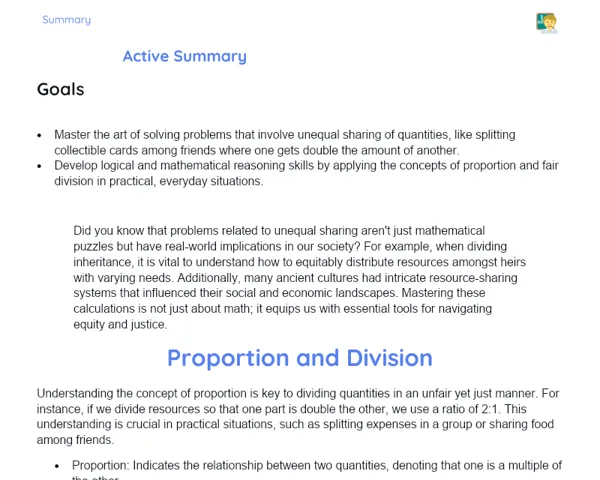Summary Tradisional | Linear Systems: Written by Matrices
Contextualization
Linear systems of equations are collections of equations that involve the same set of variables. They crop up in many areas such as engineering, economics, physics, and computer science, and are no strangers in the academic curriculum here in India. Representing these systems in matrix form is a neat trick that simplifies both the solution and analysis of complex problems. In the matrix form, expressed as Ax = b (where A is the coefficient matrix, x is the column vector of unknowns, and b is the column vector of constant terms), we have a compact and efficient method to deal with such systems.
Working with matrix forms also makes it easier to apply various algebraic and computational methods when solving a system. For instance, in engineering, linear systems help in analyzing structures or even in solving static equilibrium problems; in computer science, algorithms behind recommendation systems (like those used in platforms similar to Netflix and Spotify) rely on these solutions. Mastering the creation and manipulation of these matrix representations is crucial for developing advanced skills in linear algebra and its practical applications.
To Remember!
Definition of Linear Systems
A linear system of equations is simply a set of two or more linear equations sharing the same set of variables. These systems may be categorized as consistent, inconsistent, determined, or undetermined. The goal is to find the values of the variables that simultaneously satisfy all the equations.
While the simplest system might involve just two equations in two variables, real-life problems can demand handling several equations involving many variables. The significance of linear systems lies in their capacity to model everyday scenarios, ranging from material balances in chemical processes, analysis of electrical circuits to resource optimization in economics.
Take, for example, the set of equations: 2x + 3y = 5 4x - y = 6 Here the task is to find the values of x and y that satisfy both equations at once.
-
Linear systems are sets of equations with identical variables.
-
They may be consistent, inconsistent, determined, or undetermined.
-
They serve as models for practical problems in various fields.
Matrix Form of a Linear System
Expressing a linear system in matrix form is a compact and efficient representation. In this form, we use three key components: the coefficient matrix (A), the vector of unknowns (x), and the vector of constant terms (b). We generally write this in the form Ax = b.
Here, A—the coefficient matrix—contains the coefficients from the equations, with each row corresponding to one equation and each column representing one variable. The vector x is a column vector consisting of all the variables, while b is a column vector holding the constant terms from the right-hand side of each equation.
For instance, consider the system: 2x + 3y = 5 4x - y = 6 The coefficient matrix (A) becomes [[2, 3], [4, -1]], the variable vector (x) is [x, y]^T, and the constant vector (b) is [5, 6]^T, thereby forming the matrix equation Ax = b.
-
Matrix form offers a compact way to represent linear systems.
-
It comprises the coefficient matrix (A), the vector of unknowns (x), and the constant terms (b).
-
This form facilitates the use of algebraic and computational methods for solving the system.
Construction of the Coefficient Matrix (A)
The coefficient matrix (A) plays a central role in presenting a linear system in matrix form. It is formed by gathering together the coefficients of all the variables from each equation. Every row in the matrix corresponds to one equation, while every column stands for one variable.
The process begins by neatly arranging the equations so that the variables line up. Then, you extract the coefficients for each variable and form the matrix. For example, for a system given by: 3a - b + 4c = 7 5a + 2b - c = 3 -a + 3b + 2c = 0 The resultant coefficient matrix (A) would be [[3, -1, 4], [5, 2, -1], [-1, 3, 2]].
Getting the coefficient matrix right is very important because any mistake in extracting or placing the coefficients may lead to errors in solving the system.
-
The coefficient matrix is derived from the coefficients of the variables in the equations.
-
Each row in the matrix represents one equation and each column a single variable.
-
Its correct formation is essential for accurate results in solving the system.
Formation of the Vectors of Unknowns (x) and Constant Terms (b)
In the matrix form of a linear system, the vectors of unknowns (x) and constant terms (b) are very important. The vector of unknowns is created by listing all the variables of the system into a column vector, whereas the vector of constant terms is put together using the numbers on the right side of each equation.
For example, consider the system: x - 2y + 3z = 4 2x + y - z = 1 -3x + 4y + 2z = -2 The variable vector (x) would then be [x, y, z]^T and the constant vector (b) would be [4, 1, -2]^T.
Properly forming these vectors is critical as it lays the foundation for accurately expressing the system in matrix form and, subsequently, finding the correct solution.
-
The unknowns vector is assembled from the system's variables.
-
The constant vector consists of the terms following the equals sign in each equation.
-
Both vectors are organized as column vectors for clarity and consistency.
Practical Examples of Transformation
To cement our understanding of how a linear system can be transformed into matrix form, practical examples are very helpful. Consider this system of equations: 2x + 3y = 5 4x - y = 6 Here, we identify the coefficient matrix (A) as [[2, 3], [4, -1]], the variable vector (x) as [x, y]^T, and the constant vector (b) as [5, 6]^T, thereby leading to the matrix equation Ax = b.
For a more involved system such as: x - 2y + 3z = 4 2x + y - z = 1 -3x + 4y + 2z = -2 We form the coefficient matrix (A) as [[1, -2, 3], [2, 1, -1], [-3, 4, 2]], the vector of unknowns (x) as [x, y, z]^T, and the constant vector (b) as [4, 1, -2]^T, which gives us the matrix form Ax = b.
These examples show the step-by-step process of converting a system into its matrix form while highlighting the importance of accuracy in every step.
-
Using examples helps in understanding the matrix representation.
-
Accuracy in building the matrix and vectors is vital.
-
Working with a variety of systems aids in better problem-solving skills.
Key Terms
-
Linear Systems: A set of linear equations involving the same variables.
-
Coefficient Matrix (A): The matrix formed using the coefficients in the equations.
-
Vector of Unknowns (x): The column vector made up of the system's variables.
-
Vector of Constant Terms (b): The column vector that contains the constant numbers from each equation.
-
Matrix Form: A compact method to express a linear system as Ax = b.
Important Conclusions
In this session, we covered the essentials of linear systems represented using matrices. We discussed the concept of linear systems, how to convert these systems into matrix form, and the role each component plays in this representation. The matrix form, given as Ax = b, provides a structured and efficient way to work through systems of equations. It not only simplifies the solution process but also makes it easier to apply various algebraic and computational methods.
Learning how to correctly form the coefficient matrix (A) along with the vectors of unknowns (x) and constant terms (b) is critical for solving these systems accurately. The practical examples used throughout the lesson reinforced the step-by-step process and highlighted the importance of precision. This knowledge finds application in many real-world scenarios, whether in engineering, economics, or computer science, preparing students to tackle more advanced challenges in their future endeavors.
Study Tips
-
Review the practical examples discussed in class and try solving new systems by transforming them into the matrix form Ax = b.
-
Experiment with linear algebra software to practice constructing matrices and vectors, and explore different computational methods for solving systems.
-
Refer to specific chapters in your linear algebra textbooks that delve into linear systems and matrix representations for a deeper understanding.



